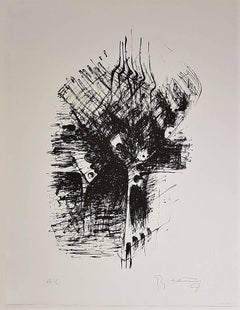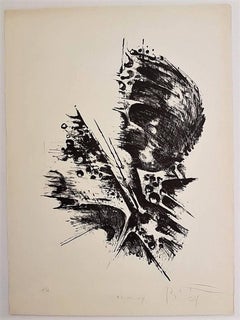Bernhard Heiliger for sale on 1stDibs
Bernhard Heiliger (11 November 1915, Stettin - 26 October 1995, Berlin) was a German artist. He was considered "West Germany's foremost sculptor", and his large public artworks are a prominent presence in many German cities, especially Berlin.
Heiliger began his artistic education with an apprenticeship as a stone carver and a course of study at the Stettiner Werkschule für Gestaltende Arbeiten from 1933-36 under Kurt Schwerdtfeger, who had been a student of the Bauhaus. After this he attended the Staatlichen Hochschule für bildende Künste (National College of Visual Arts) in 1938, where he studied under Arno Breker. In 1941 he was drafted into the army and served as a radio operator on the Eastern Front for two years, before he received an exemption from military service through the intervention of Breker. Despite this he was drafted again in 1944, after which he fled as a deserter through northern Germany.
In May 1946 Heiliger exhibits with the painter Fritz Ascher at the Karl Buchholz Gallery in Berlin. Heiliger's design for the Memorial to Unknown Political Prisoners (1953) brought him his first international recognition, earning him the Prize of the National Government and a prize from the Institute of Contemporary Arts. This was followed by his participation in several prominent international exhibits, such as the documenta I & II in Kassel (1955 and 1959) and the Venice Biennale (1956), and by commissions such as sculptures for the German pavilion at the 1958 World's Fair in Brussels. In 1956 he became a member of the Berlin Academy of Art. In 1974 he was recognized with the Federal Cross of Merit, and in 1984 was awarded an honorary membership in the Deutscher Künstlerbund.
He died in Berlin in 1995, and was buried in Berlin's Dahlem Cemetery (Friedhof Dahlem).
Heiliger's diverse output stretches from his early, organically abstracted figures to his late nonobjective, geometric abstractions. His early work (1945–1962), focuses on the human figure, which is treated in an organic style influenced by Aristide Maillol and Henry Moore. Also from this period is a series of portrait busts of prominent contemporary Germans. The artist departed from the human figure in his second period (1962–1970), instead developing imagery of the "flight of birds and vegetable forms"[4] influenced by the nonrepresentational Informel style. The seven-meter-high The Flame (Flamme, 1962–63), commissioned by the city of Berlin for Ernst-Reuter-Platz,[1] is considered the key work in the transition between the early and middle periods.[4] The Five Continents (Die fünf Erdteile, 1961), by contrast, still alludes to the human figure in the torso-like shapes that make up the composition.
Finding the Right abstract-prints-works-on-paper for You
Explore a vast range of abstract prints on 1stDibs to find a piece to enhance your existing collection or transform a space.
Unlike figurative paintings and other figurative art, which focuses on realism and representational perspectives, abstract art concentrates on visual interpretation. An artist may use a single color or simple geometric forms to create a world of depth. Printmaking has a rich history of abstraction. Through materials like stone, metal, wood and wax, an image can be transferred from one surface to another.
During the 19th century, iconic artists, including Edvard Munch, Paul Cézanne, Georgiana Houghton and others, began exploring works based on shapes and colors. This was a departure from the academic conventions of European painting and would influence the rise of 20th-century abstraction and its pioneers, like Pablo Picasso and Piet Mondrian.
Some leaders of European abstraction, including Franz Kline, were influenced by the gestural shapes of East Asian calligraphy. Calligraphy interprets poetry, songs, symbols or other means of storytelling into art, from works on paper in Japan to elements of Islamic architecture.
Bold, daring and expressive, abstract art is constantly evolving and dazzling viewers. And entire genres have blossomed from it, such as Color Field painting and Minimalism.
The collection of abstract art prints on 1stDibs includes etchings, lithographs, screen-prints and other works, and you can find prints by artists such as Joan Miró, Alexander Calder and more.


